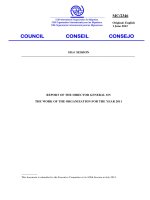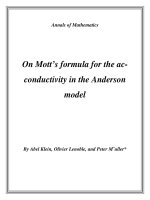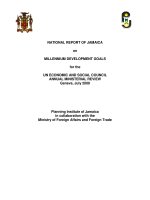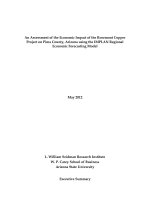Immobilization of ZnO nanoparticles on fluorinated perlite granules for the photocatalytic degradation of methylene blue
Bạn đang xem bản rút gọn của tài liệu. Xem và tải ngay bản đầy đủ của tài liệu tại đây (1.48 MB, 7 trang )
Physical Sciences | Chemistry
Immobilization of ZnO nanoparticles
on fluorinated perlite granules for the
photocatalytic degradation of methylene blue
Nguyet Anh Pham, Thi Huynh Nhu Nguyen, Tuan Ngoc Tran, Quy Tu Nguyen, Tien Khoa Le*
University of Science - Vietnam National University, Ho Chi Minh City
Received 15 June 2017; accepted 11 September 2017
Abstract:
The fluorination of perlite granules and the immobilization of ZnO
nanoparticles on the perlite surface were carried out at the same time by a
simple impregnation method to create new highly photocatalytic materials
which are easily separated from reaction solutions after treatment. The
influence of perlite fluorination on the crystal structure, morphology, UVvisible absorption, and surface functional groups of ZnO, as well as on the
ZnO content on perlite, was respectively characterized by XRD, FE-SEM,
UV-Visible diffuse reflectance, FTIR and atomic absorption spectrometry.
The photocatalytic activity was evaluated via the extent of degradation
of methylene blue under UVA irradiation. According to the results, the
fluorination of perlite leads to numerous effects on ZnO, such as the decline
of ZnO cell parameters, the increase of ZnO content on perlite granules
(resulting in the enhancement of light absorption in UVA range), and the
decrease of ZnO particle size, which can effectively improve its photocatalytic
performance. The photocatalysts were also found to be able to stay afloat on
water, allowing for easy separation from the reaction solution.
Keywords: coating, fluorination, perlite granules, photocatalytic activity, ZnO
nanoparticles.
Classification number: 2.2
Introduction
Due to their chemical structure and
stability, most of the dyestuffs used in
the textile industry, including methylene
blue, are resistant to solvents and are
difficult to eliminate by conventional
wastewater treatment methods such as
cost-effective biological techniques [13]. Although it is not a strongly toxic
compound, exposure to methylene blue
can cause rapid pulse, shock, cyanosis,
and tissue necrosis in humans [4]. Hence,
the release of waste water containing
methylene blue can lead to harmful
environmental effects and damages to
human health. Over the past few decades,
the use of semiconductor photocatalysts
based on TiO2 nanopowders has proven
to be a promising method of waste
water treatment since various organic
pollutants including methylene blue
and other organic dye molecules can
be completely degraded under UV
irradiation in the presence of these
photocatalysts [5-9]. Besides TiO2, ZnO
is another semiconductor which has
been investigated in recent years as an
excellent material for photocatalytic
processes owing to its photosensitivity,
high stability, and low toxicity [10, 11].
In some photodegradation experiments,
ZnO nanopowders exhibit activity
superior to that of TiO2 for the treatment
of dye wastewater [12, 13]. However,
there are two major drawbacks for
the application of these suspended
particles in practical wastewater
treatment procedures: (i) the scattering
of UV light by nanoparticles can limit
photocatalytic activity and (ii) the
catalytic nanoparticles are difficult to
separate from the reaction solution [14].
Therefore, it is necessary to immobilize
semiconductor
photocatalysts
on
solid substrates in order to solve these
problems.
Many materials have been studied
for the immobilization of photocatalytic
TiO2 particles, such as glass [14, 15],
stainless steel plate [16, 17], polymers
[18, 19], alumina [20], and ceramics
[21]. Recently, Hosseini, et al. [22]
investigated the immobilization of TiO2
on perlite granules for the photocatalytic
degradation of phenol. Granular perlite
is an amorphous volcanic glass with
high porosity, making it suitable as a
potential substrate for TiO2 nanopowder.
The second advantage of perlite granules
is that they are very light, which allows
Corresponding author: Email:
*
september 2017 l Vol.59 Number 3
Vietnam Journal of Science,
Technology and Engineering
25
Physical Sciences | Chemistry
them to stay afloat on the surface of
wastewater [22]. As a result, the TiO2
photocatalyst coated on perlite granules
is easily exposed to the available
radiation source to ensure efficient light
absorption [22, 23]. Unfortunately,
the coating of TiO2 particles is mostly
distributed on the external surfaces
of perlite granules [23] which usually
consist of smooth flat layers. This
may limit the mechanical adhesion
between photocatalytic particles and
the perlite surface and then hinder the
immobilization of nanopowders. Thus
the surface of perlite granules still needs
to be modified in order to make it an
effective substrate for photocatalysts.
However, so far, up to our best
knowledge, no research has been
conducted on the modification of perlite
surfaces for the immobilization of ZnO
catalysts. Since perlite granules are
mainly composed of SiO2 (73%) [24], it
is suggested that fluoride ions can modify
the perlite surface by slowly corroding
its silica components. Therefore, in
this work, we have prepared new
photocatalytic materials based on
ZnO nanoparticles coated on fluoridemodified perlite granules by a simple
one-step impregnation method in order
to improve the bonding between ZnO
particles and perlite substrate and then
enhance their photocatalytic activity.
The influence of fluoride contents used to
modify perlite surfaces on the coating of
ZnO and the photocatalytic performance
were also investigated.
Experimental section
Sample preparation
The starting materials Zn(NO3)2.6H2O,
K2C2O4.H2O and KF (99%, extra pure
grade) were purchased from Sigma
Aldrich. Methylene blue (MB) (analytical
grade) was purchased from Merck. These
chemicals were used as received without
further purification. Perlite granules
26
Vietnam Journal of Science,
Technology and Engineering
obtained from Ninh Binh province
(Vietnam) were treated with H2SO4
solution (2 mol/l) at 80 - 100oC for 30
minutes. Distilled water was used in all
the experiments.
For the preparation of ZnO coated
on fluoride-modified perlite granules,
firstly, Zn(NO3)2.6H2O was separately
dissolved in water to obtain 250 ml
of Zn2+ solution (1 mol/l). Then 5 g
of perlite granules were added to this
Zn2+ solution under regular stirring at
room temperature. After that, 250 ml
of a solution containing both K2C2O4
(1 mol/l) and KF (the KF concentration
varied from 1 to 3 mol/l) was added to
the Zn2+ solution to fluorinate the surface
of the perlite granules and to create the
white ZnC2O4 precipitate deposited
on their surface. The slurry containing
perlite granules was regularly stirred for
30 minutes for the fluorination. Next,
these perlite granules were separated
from the slurry, washed with distilled
water, dried at 150oC for two hours, and
heated in air at 500oC for two hours. In
the following manuscript, these samples
were labelled as PZnOF-X (X is equal
to 1, 2, and 3 corresponding to the
KF concentration of 1, 2, and 3 mol/l,
respectively).
ZnO was also coated on bare perlite
granules (labelled as PZnO) by the same
process without using KF. Moreover,
fluorinated perlite granules without
ZnO immobilization were prepared by
stirring 5 g of granular perlite in 500 ml
of KF solution (1 mol/l) and then dried
at 150oC during two hours in order to
investigate the effects of fluorination on
granular perlite.
Characterization
The surface morphology and
particle size of PZnO and PZnOF-X
catalysts were studied by field emission
scanning electron microscopy (FESEM) using a HITACHI S-4800 with an
september 2017 l Vol.59 Number 3
acceleration voltage at 10 kV. FE-SEM
micrographs of bare perlite granules and
fluorinated perlite granules without ZnO
immobilization were also taken. Their
specific surface area was measured
with a NOVA 1000e instrument and
calculated using the BET (BrunauerEmmett-Teller) equation.
The crystalline structure and phase
composition of PZnO and PZnOF-X
samples were characterized by powder
X-ray diffraction (XRD) measurements,
which were carried out by a BRUKERBinary V3 X-ray diffractometer using
Cu Kα radiation (λ = 1.5406 Å). The
accelerating voltage and the applied
current were 40 kV and 40 mA,
respectively. The Rietveld refinements
were carried out using Fullprof 2009
structure refinement software [25].
In order to investigate the surface
functional groups of prepared catalysts,
their FT-IR spectra were recorded in the
4000-400 cm-1 frequency range at room
temperature using a Bruker VERTEX 70
spectrometer.
The quantity of ZnO coated on the
surface of different perlite samples
was evaluated by atomic absorption
spectrometry using a Shimadzu AA6300 spectrometer. The ZnO/perlite and
FZnO/perlite samples were separately
ground into fine powder with a mortar
and pestle and then stirred in HCl
solution (6 mol/l) for 24 hours. Then the
quantity of Zn2+ ions was measured at a
wavelength of 213.9 nm.
UV-Visible
diffuse
reflectance
spectra of the catalysts were measured
using a Perkin-Elmer Lamda 850
Spectrophotometer which is equipped
with a 15 cm diameter integrating
sphere bearing the holder in the bottom
horizontal position and calibrated with
a certified Spectralon white standard
(Labsphere, North Sutton, USA).
The spectra were recorded at room
Physical Sciences | Chemistry
temperature in steps of 1 nm, in the
range of 300-400 nm with a bandwidth
of 2 nm.
a
b
c
d
e
f
Photocatalytic tests
Results and discussions
Figures 1A and 1B present the FESEM micrographs of perlite granules
before and after fluorination, respectively.
It was observed that the surface of
bare granular perlite is composed of
relatively smooth terraces which are
randomly oriented and superimposed
on each other. When the perlite sample
was fluorinated, the surface was clearly
corroded with increased roughness and
the appearance of various shallow holes.
BET measurements also indicated the
increase of the specific surface area of
perlite granules from 0.415 to 0.498
m2/g when fluorinated, confirming the
corrosion role of KF on perlite which
may improve the immobilization of ZnO
nanoparticles on the perlite surface. For
Fig. 1. FE-SEM micrographs at different magnifications of perlite granules (A),
fluorinated perlite granules (B), PZnO (C, D) and PZnOF-2 (E, F).
Intensity
Intensity(a.u.)
(a.u.)
The photocatalytic activities of
PZnO and PZnOF-X samples were
evaluated via the degradation of MB.
The photocatalytic reactor consists of a
glass beaker containing 250 ml of MB
solution (10-5 mol/l) with 2.0 grams of
catalysts, cooled by continuous water
flow and stirred continuously by a
mechanic agitator. The outer wall of the
reactor is covered with an aluminium
layer to block out any exterior light. The
pH of suspensions was fixed at 7 and the
reaction temperature was maintained at
30°C during the experiments. Prior to
the irradiation, the solution containing
catalysts was stirred for 60 minutes
in the dark in order to obtain the MB
adsorption equilibrium. Then the
reaction solution was irradiated by an
8-W UV Philips light lamp placed about
10 cm above the solution surface. During
the illumination, 5 ml of suspension was
sampled and analyzed with an SP-300
Optima spectrophotometer.
PZnOF-3
PZnOF-3
PZnOF-2
PZnOF-2
PZnOF-1
PZnOF-1
PZnO
PZnO
Perlite
Perlite
ZnO
ZnO
Willemite Zn2SiO4 Willemite Zn SiO
2
4
10
10
20 20
30
30 40
2q (o)
50
40
2q (o)
60 50
70
60
70
Fig. 2. XRD patterns of perlite, PZnO and fluorinated PZnO samples.
september 2017 l Vol.59 Number 3
Vietnam Journal of Science,
Technology and Engineering
27
Physical Sciences | Chemistry
the PZnO sample, Fig. 1C and Fig. 1D
display the presence of ZnO polyhedral
particles, which demonstrates the
successful immobilization of ZnO on the
surface of perlite. These particles were
found to be non-uniform in size (with a
diameter of 100 - 300 nm) and tended to
agglomerate. When ZnO was coated on
fluorinated perlite (Fig. 1E and Fig. 1F
for PZnOF-2 sample), the ZnO particles
also appeared in large agglomerates
but their particle size was reduced to
around 50 nm. It should be noted that
in this sample, nearly all the surfaces of
fluorinated perlite granules were covered
with ZnO nanoparticles whereas in
the PZnO sample, the perlite surface
was only partially covered with ZnO.
Therefore, it seems that the fluorination
of perlite does not only reduce the ZnO
particle size but also increases the ZnO
content on the perlite surfaces.
Powder XRD was used to follow
the effects of perlite fluorination on
the crystallite structures and phase
compositions of ZnO coated on perlite
granules. From Fig. 2, the perlite sample
shows the XRD pattern in an arc-shaped
baseline without any diffraction peak,
confirming the amorphous structure of
these granules, which is in agreement
with Hosseini’s findings [22]. For the
pattern of PZnO powder, we observed
a series of characteristic peaks at 31.77°
((100) line), 34.43° ((002) line), 36.26°
((101) line), 47.55° ((102) line) and
56.60° ((110) line). These diffraction
peaks are in accordance with the zincite
phase of ZnO (space group P63mc,
JCPDS No. 36-1451), which confirms
that ZnO was successfully deposited on
the surface of perlite granules. Moreover,
when coating ZnO on fluorinated perlite
with increasing KF concentration from
1 to 2 mol/l, no peaks of impurity were
observed, suggesting that the fluorination
did not modify the phase composition of
ZnO. However, for the PZnOF-3 sample,
the XRD pattern showed the apparition
of willemite Zn2SiO4 phase (space group
R-3, JCPDS No. 37-1485), identified
by the diffraction peaks at 21.68o,
25.31o and 41.60o. The formation of this
additional crystallographic phase may be
attributed to the reaction between ZnO
and the silicate components in the perlite
composition, which was promoted by
the addition of KF. Furthermore, it was
observed that the cell parameters of
ZnO were modified by the fluorination
(Table 1). When ZnO was immobilized
on fluorinated perlite with increased
fluoride content, the cell parameters and
the cell volume were decreased.
Table 2 represents the ZnO content in
our samples measured by calculating the
Zn concentration via atomic absorption
spectrometry. The PZnO sample only
contains 8.08 mg Zn g-1 product. For
ZnO nanoparticles immobilized on
fluorinated perlite, the ZnO content was
strongly increased, which is consistent
with the observation in the FE-SEM
study. The highest ZnO content was
found in the PZnOF-2 sample with 71.44
mg Zn g-1 product - nearly 9 times higher
Table 1. Cell parameters and cell volumes of ZnO in PZnO and PZnOF samples.
Sample
Cell parameters
Cell volume (Å3)
a (Å)
c (Å)
PZnO
3.25097
5.20838
47.67154
PZnOF-1
3.25031
5.20688
47.63846
PZnOF-2
3.24954
5.20495
47.59824
PZnOF-3
3.2493
5.20428
47.58509
28
Vietnam Journal of Science,
Technology and Engineering
september 2017 l Vol.59 Number 3
than that found in the PZnO sample. This
result suggests that KF may corrode the
silicate component of perlite surfaces
during the fluorination to improve the
coating of ZnO. However, when KF
concentration was increased to 3 mol/l,
the ZnO content dramatically decreased
(28.45 mg Zn g-1 product), indicating
that a high KF amount is capable of
damaging the surface of perlite granules
and thus lowering the bonding between
ZnO nanoparticles and perlite granules.
Figure 3 presents the FT-IR spectra
of PZnO and PZnOF-2 samples. From
these spectra, two broad absorption
peaks were observed around 1053.06 and
789.04 cm-1, which are attributed to the
stretching vibrations of Si-O and Si-O-Si
bonds on the surface of perlite granules
[26]. These spectra also display a sharp
peak at 459.74 cm-1 due to the stretching
vibration of Zn-O [27], confirming the
presence of ZnO deposited on the perlite
surface. For the PZnO sample, another
weak peak was detected at 1384.13
cm-1. This peak may be ascribed to
the C-O vibration originated from the
adsorption of CO2 on the surface of
perlite granules [28, 29]. Nevertheless,
this peak disappeared when the ZnOperlite system was fluorinated. It should
be noted that the fluorination of perlite
promotes the coating of ZnO onto perlite
granules, which may cover all the perlite
surface and then hinder its adsorption of
CO2.
The optical responses of PZnO
and PZnOF-2 samples were analyzed
using UV-visible diffuse reflectance
spectroscopy (Fig. 4). The spectrum of
PZnO material shows a broad absorption
band in the UV range below 400 nm
(maximum absorption at the wavelength
of 200-300 nm). When ZnO was
immobilized on fluorinated perlite, the
intensity of the absorption band in the
visible zone slightly decreased whereas
the absorption peak of the UV region
Physical Sciences | Chemistry
Table 2. ZnO content and rate constant of MB bleaching under UVA light
illumination on PZnO and PZnOF samples.
Sample
ZnO content determined by
AAS (mg Zn g-1 sample)
Rate constant of MB bleaching
under UVA illumination (h-1)
PZnO
8.08
0.33
PZnOF-1
21.31
0.87
PZnOF-2
71.44
1.23
PZnOF-3
28.44
0.90
Intensity (a.u.)
PZnOF-2
459.74
PZnO
789.28
461.02
1384.13
1054.73
4000
3500
3000
2500
2000
1500
-1
Wavenumber (cm )
1000
500
Fig. 3. FTIR spectra of PZnO and PZnOF-2 samples.
1.0
PZnO
PZnOF-2
Absorption (a.u.)
0.8
0.6
0.4
0.2
0.0
200
300
400
500
600
Wavelength (nm)
700
800
Fig. 4. UV-visible absorption spectra of PZnO and PZnOF-2 samples.
900
strongly rose in the range of 300-400
nm. This enhanced UV absorption of the
PZnOF-2 sample can also be explained
by the increase of ZnO content owing to
the fluorination of perlite.
The UVAlight induced photocatalytic
activity of PZnO and PZnOF samples
was evaluated via the photocatalytic
MB degradation. The time-dependent
profiles of MB degradation in the
presence of our catalysts under UVA
light irradiation (Fig. 5) prove that
the net decomposition of MB in the
aqueous solution followed the pseudofirst-order Langmuir-Hinshelwood
kinetic model. Hence, the rate constant
of this reaction was determined by
plotting ln(C/C0) versus time (C is
the MB concentration at time t and C0
is the initial MB concentration) and
presented in Table 2. The catalytic tests
indicated that the fluorination of perlite
effectively improved the photocatalytic
performance of ZnO supported on the
perlite granules. In fact, the rate constant
(k) of MB degradation in the presence of
the PZnO sample only reached 0.33 h-1
whereas the PZnOF-2 catalyst showed
the best performance with k = 1.23 h-1,
which was about four times higher than
that of the PZnO catalyst. The increase
of photocatalytic activity in our samples
can be explained by two factors. Firstly,
based on the atomic absorption spectra
and UV-visible reflectance diffuse
spectra, the fluorination of perlite was
found to successfully modify the surface
of perlite granules, which increased the
ZnO content on the perlite surface and
then enhanced the UVA absorption of
catalysts. It has been reported that the
high photon absorption can promote the
formation of photogenerated electrons
and holes and then improve the
photocatalytic activity [7, 30]. Secondly,
the fluorination of perlite also decreased
the particle size of ZnO. As a result, the
active sites of photocatalytic ZnO were
enhanced by the perlite fluorination,
september 2017 l Vol.59 Number 3
Vietnam Journal of Science,
Technology and Engineering
29
Physical Sciences | Chemistry
2.5
“Photochemical
and
photocatalytic
of
cypermethrin under UV radiation”, Der pharma
chemica, 2, pp.152-158.
PZnO
PZnOF-1
PZnOF-2
PZnOF-3
2.0
[4] H. Ma, Q. Zhuo, B. Wang (2009),
“Electro-catalytic degradation of methylene blue
wastewater assisted by Fe2O3-modified kaolin”,
Chem. Eng. J., 155, pp.248-253.
Ln(C0/C)
1.5
[5] Y. Zhang, T. Oyama, A. Aoshima,
H. Hidaka, J.C. Zhao, N. Serpone (2001),
“Photooxidative N-demethylation of methylene
blue in aqueous TiO2 dispersions under UV
irradiation”, J. Photochem. Photobiol. A, 140,
pp.163-172.
1.0
[6] H. Lachheb, E. Puzenat, A. Houas, M.
Ksibi, E. Elaloui, C. Guillard, J.M. Herrmann
(2002), “Photocatalytic degradation of various
types of dyes (Alizarin S, Crocein Orange G,
Methyl Red, Congo Red, Methylene Blue) in
water by UV-irradiated titania”, Appl. Catal. B,
39, pp.75-90.
0.5
0.0
0.0
0.5
1.0
1.5
UVA illumination time (h)
2.0
Fig. 5. Ln(C0/C) versus time plot of MB bleaching under UV irradiation on
PZnO and PZnOF samples. C is the MB concentration (mol/l) at time t and C0
is the initial MB concentration (mol/l).
[7] A. Vijayabalan, K. Selvam, R. Velmurugan,
M. Swaminathan (2009), “Photocatalytic activity
of surface fluorinated TiO2-P25 in the degradation
of Reactive Orange 4”, J. Hazard. Mater., 172,
pp.914-921.
leading to the rise of photocatalytic
properties. However, when the perlite
surface was fluorinated more strongly,
with a KF concentration of 3 mol/l,
the ZnO content was decreased on the
PZnOF-3 sample, resulting in a decline
in photocatalytic performance.
[8] H. Shin, T.H. Byun, S. Lee, S.T. Bae, H.S.
Jung (2013), “Surface hydroxylation of TiO2 yields
notable visible-light photocatalytic activity to
decompose rhodamine B in aqueous solution”, J.
Phys. Chem. Solids, 74, pp.1136-1142.
These results showed that the
immobilization of ZnO nanoparticles
supported on fluorinated perlite granules
may be a simple and efficient method to
obtain highly photocatalytic materials
which are easily separated from solutions
after treatment.
Conclusions
In this study, ZnO nanoparticles were
developed on fluorinated perlite granules
with various KF concentrations by a
simple one-step impregnation method
in order to study the effects of perlite
fluorination on the crystal structure,
morphology, optical properties, ZnO
content, and photocatalytic activity of
ZnO/perlite. The experimental results
showed that the fluorination of perlite
does not only enhance the ZnO content
on perlite surfaces, increasing the UVA
30
Vietnam Journal of Science,
Technology and Engineering
absorption, but also decreases the
particle size of ZnO. These modifications
strongly improved the photocatalytic
performance of our materials. The
fluorinated sample prepared with KF
concentration of 2 mol/l was found to
be the optimal photocatalyst. When the
KF concentration was further increased,
the ZnO content on perlite granules
dramatically decreased, leading to the
reduction of photocatalytic activity.
ACKNOWLEDGEMENTS
The authors would like to thank
the University of Science - Vietnam
National University, Ho Chi Minh City
for their technical support.
REFERENCES
[1] R. Asahi, T. Morikawa, T. Ohwaki, K.
Aoki, Y. Taga (2001), “Visible-light photocatalysis
in nitrogen-doped titanium oxides”, Science,
293, pp.269-271.
[2] E. Khelifi, H. Gannoun, Y. Touhami,
H. Bouallagui, M. Hamdi (2008), “Aerobic
decolourization of the indigo dye-containing
textile wastewater using continuous combined
bioreactors”, J. Hazard. Mater., 152, pp.683689.
[3]
R.S.
Dave,
september 2017 l Vol.59 Number 3
A.R.
Patel
(2010),
[9] T.K. Le, D. Flahaut, H. Martinez, H.K.H.
Nguyen, T.K.X. Huynh (2015), “Study of the
effects of surface modification by thermal shock
method on photocatalytic activity of TiO2 P25”,
Appl. Catal. B, 165, pp.260-268.
[10] A. Segura, J.A. Sans, F.J. Manjon, A.
Munoz, M.J. Herrera-Cabrera (2003), “Optical
properties and electronic structure of rock-salt
ZnO under pressure”, Appl. Phys. Lett., 83, pp.
278-280.
[11] L. Jing, D. Wang, B. Wang, S. Li, B.
Xin, H. Fu, J. Sun (2006), “Effects of noble metal
modification on surface oxygen composition,
charge separation and photocatalytic activity
of ZnO nanoparticles”, J. Mol. Catal. A, 244,
pp.193-199.
[12] K. Gouvea, F. Wypych, S.G. Moraes,
N. Duran, N. Nagata, P. Peralta-Zamora
(2000), “Semiconductor-assisted photocatalytic
degradation of reactive dyes in aqueous solution”,
Chemosphere, 40, pp.433-440.
[13] J. Han, Y. Liu, N. Singhal, L. Wang,
W. Gao (2012), “Comparative photocatalytic
degradation of estrone in water by ZnO and
TiO2 under artificial UVA and solar irradiation”,
Chem. Eng. J., 213, pp.150-162.
[14] M.A. Behnajady, N. Modirshahla, M.
Mirzamohammady, B. Vahid, B. Behnajady
(2008), “Increasing photoactivity of titanium
Physical Sciences | Chemistry
dioxide immobilized on glass plate with
optimization of heat attachment method
parameters”, J. Hazard. Mater., 160, pp.508513.
[15] S. Gelover, P. Mondragon, A. Jimenez
(2004), “Titanium dioxide sol-gel deposited
over glass and its application as a photocatalyst
for water decontamination”, J. Photochem.
Photobiol. A, 165, pp.241-246.
[16] J. Yu, H. Yu, C.H. Ao, S.C. Lee, J.C. Yu,
W. Ho (2006), “Preparation, characterization and
photocatalytic activity of in situ Fe-doped TiO2
thin films”, Thin Solid Films, 496, pp.273-280.
[17] S.W. da Silva, J.B. Bortolozzi, E.D.
Banús, A.M. Bernardes, M.A. Ulla (2016), “TiO2
thick films supported on stainless steel foams and
their photoactivity in the nonylphenol ethoxylate
mineralization”, Chem. Eng. J., 283, pp.12641272.
[18] Z. Niu, F. Gao, X. Jia, W. Zhang, W.
Chen, K. Qian (2006), “Synthesis studies of
sputtering TiO2 films on poly(dimethylsiloxane)
for surface modification”, Colloids Surfaces A:
Physicochem. Eng. Aspects, 272, pp.170-175.
[19] J. Zeng, S.L. Liu, J. Cai, L. Zhang
(2010), “TiO2 immobilized in cellulose matrix for
photocatalytic degradation of phenol under weak
UV light irradiation”, J. Phys. Chem. C, 114,
pp.7806-7811.
Newsletter, 26, pp.12-19.
[20] S. Sakthivel, M.V. Shankar, M.
Palanichamy, B. Arabindoo, V. Murugesan
(2002), “Photocatalytic decomposition of leather
dye - Comparative study of TiO2 supported
on alumina and glass beads”, J. Photochem.
Photobiol. A, 148, pp.153-159.
[26] W.R. Taylor (1990), “Application of
infrared spectroscopy to studies of silicate glass
structure: Examples from the melilite glasses and
the systems Na2O-SiO2 and Na2O-Al2O3-SiO2”,
Proc. Indian Acad. Sci. (Earth Planet Sci.), 99,
pp.99-117.
[21] S. Ke, X. Cheng, Q. Wang, Y. Wang, Z.
Pan (2014), “Preparation of a photocatalytic TiO2/
ZnTiO3 coating on glazed ceramic tiles”, Ceram.
Int., 40, pp.8891-8895.
[22] S.N. Hosseini, S.M. Borghei,
M.
Vossoughi,
N.
Taghavinia
(2007),
“Immobilization of TiO2 on perlite granules for
photocatalytic degradation of phenol”, Appl.
Catal. B, 74, pp.53-62.
[23] Y. Shavisi, S. Sharifnia, S.N. Hosseini,
M.A. Khadivi (2014), “Application of TiO2/perlite
photocatalysis for degradation of ammonia in
wastewater”, J. Ind. Eng. Chem., 20, pp.278283.
[24] D. Herskovitch, I.J. Lin (1996),
“Upgrading of raw perlite by a dry magnetic
technique”, Mag. Elect. Sep., 7, pp.145-161.
[25] J. Rodriguez-Carvajal (2001), “Recent
developments of the program FULLPROF.
Commission of Powder Diffraction”, IUCr
[27] K.S. Babu, A.R. Reddy, C. Sujatha, K.V.
Reddy, A.N. Mallika (2013), “Synthesis and
optical characterization of porous ZnO”, J. Adv.
Ceram., 2, pp.260-265.
[28] A.C. Tas, P.J. Majewski, F. Aldinger
(2002), “Synthesis of gallium oxide hydroxide
crystals in aqueous solutions with or without urea
and their calcination behavior”, J. Am. Ceram.
Soc., 85, pp.1421-1429.
[29] Y. Zhao, R.L. Frost, J. Yang, W.N.
Martens (2008), “Size and morphology control
of gallium oxide hydroxide GaO(OH), nano- to
micro-sized particles by soft-chemistry route
without surfactant”, J. Phys. Chem. C, 112,
pp.3568-3579.
[30] H. Zhang, C. Hu (2011), “Effective solar
absorption and radial microchannels of SnO2
hierarchical structure for high photocatalytic
activity”, Catal. Commun., 14, pp.32-36.
september 2017 l Vol.59 Number 3
Vietnam Journal of Science,
Technology and Engineering
31









